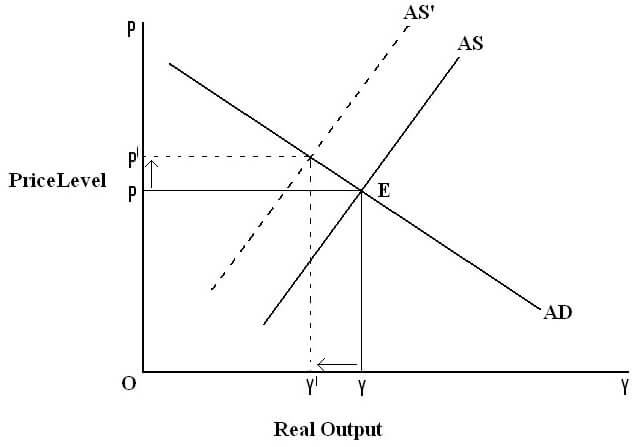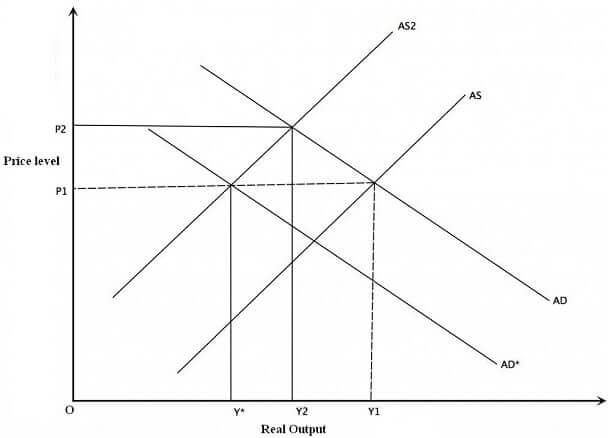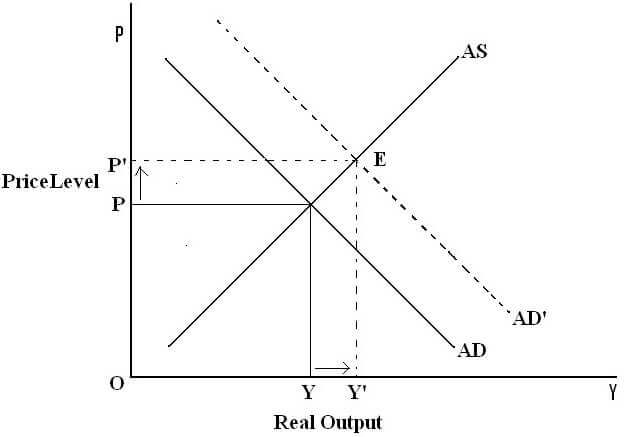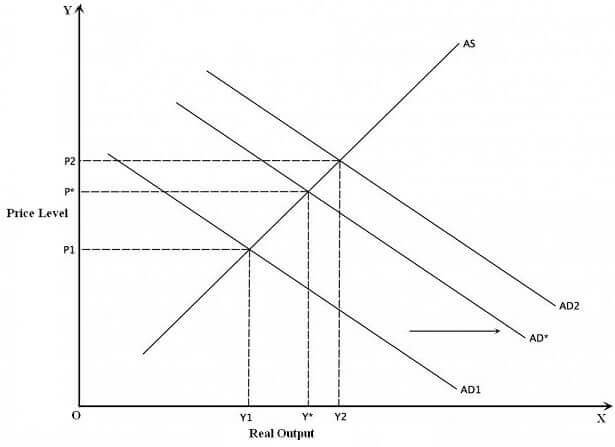Inflation macroeconomics
Using the aggregate demand and supply analysis, explain with the aid of diagrams the concept of (i) cost-push inflation and (ii) demand push inflation by assessing how the two impacts on the price level, real GDP and employment.
What is Cost Push Inflation?
Cost push inflation refers to a phenomenon in which the general level of prices rises due to an increase in the cost of producing goods and services i.e. an increase in the cost of inputs such as labor, raw materials e.t.c.
Analysis of Cost Push Inflation with AD-AS model
We know that supply of a commodity depends upon the cost of producing that particular commodity. When the prices of the inputs rises, the cost of producing output for the firm rises and it becomes costly for the firm to carry out its production. To combat this, firms decides to cut back their production. This leads to a reduction in supply from the individual firms which further leads to an overall reduction in the aggregate supply. Whereas, on the other hand the increase in the cost of producing goods and services does not affect consumer choices in any way and therefore, there is no change in the quantity demanded and thus the level of aggregate demand in the economy remains consistent.
With aggregate demand being consistent and aggregate supply being lesser than before, the new equilibrium occurs at a point where general price level is higher than before which means inflation.
Lets understand this with the help of a diagram:
Cost Push Inflation

The above diagram offers a diagrammatic representation of the Cost Push Inflation. The initial aggregate demand curve is shown by the AD curve whereas the initial aggregate supply curve is shown by the AS curve. The Equilibrium occurs at the point where AD and AS curve intersect. In the above diagram, this occurs at point E and at this point, the price level is OP and real output equals OY.
When cost of the inputs increases, aggregate supply curve shifts backward. Initial aggregate supply curve AS shifts backward to new aggregate supply curve AS’. The aggregate demand curve remains constant at its initial level because change in price of inputs does not affect individual demand and therefore there is no change on aggregate demand. The new equilibrium is achieved at point E’. At this new equilibrium point, price level is OP’ and real output equals OY’.
This shows that due to a change in the aggregate supply, price level rises from P to P’ and income rises from Y to Y’. When supply decreases, then the general price level rises. This is termed as cost push inflation because the cost of production pushes the price level upwards.
Effect of Cost Push Inflation on Price Level and Real Output:
| Price level | Real output | |
| Cost Push Inflation | Increases | Decreases |
The above table shows the overall effects of cost push inflation on price level and real output.
Why does the price of inputs rise?
There can be many reasons due to which the prices of inputs increase. Lets understand a few of them one by one.
The first major reason can be Natural Disasters. Whenever a natural calamity such as floods, droughts etc. occurs, it has a devastating effect on our economy as it destroys the farms and livelihoods. This affects our natural resources and therefore leads to their depletion. This creates a shortage in the availability of the raw materials and due to this decreased availability, the prices of raw materials rise.
Another reason that might lead to an increase in the prices of inputs is Higher Wages. Labor is the most important input for a firm and wages to these labor units forms a larger percentage of costs for firms. Labor unions might create pressure and demand for a hike in their wages. This leads to an increase in costs for the firms.
The third reason that constitutes to cost push inflation is increase in the prices of raw materials. There are various materials such as steel, basic chemicals etc. which are used, directly or indirectly in almost all the industries. The increase in the prices of these raw materials leads to an increase in the cost of producing goods and services for the producers.
Fourth reason that might lead to an increase in the prices of goods and services is the imported inflation. A devaluation of our currency will increase the domestic prices of imports. Therefore, post the devaluation period we might experience inflation because of the increased costs of imports. We now have to pay extra money for the same amount of goods purchased than we paid before. There are a number of several other reasons too due to which price for a commodity can rise.
Countering Cost Push Inflation
Cost Push Inflation can be tackled using supply side economics. Supply side economics refers to the practices aimed at increasing the aggregate supply and shifting the aggregate supply curve to the right. The only drawback is that in the short run, it is not easy for the firms to raise their output because changes in the production capabilities takes time. So, rather than shifting the supply, aggregate demand can be reduced because in the short run, it is easier to influence demand. Central bank can do this by introducing its Contractionary monetary policy. Contractionary monetary policy would help reduce the money supply in the economy which leads to a reduction in the aggregate demand because purchasing power of the people reduces. This leads to a shift in the aggregate demand curve backwards due to which prices fell.

In the above diagram, aggregate supply curve has shifted to AS2 because of the increase in the prices of inputs. In its effect, prices rose from P1 to P2 and Real output fell down from Y1 to Y2. The central bank now implements Contractionary monetary policy because of which aggregate demand shifts from AD to AD*. The new equilibrium price is P1 and output is Y*.
The important result over is that the new equilibrium output is at Y* which is lower than the initial output levels Y1 and Y2 but this is at a lower price level. This shows that the prices do have came down due to the Contractionary monetary policy but this happens only at the cost of lower economic growth and unemployment in the short run.
What is Demand Pull Inflation?
Demand pull inflation refers to a phenomenon in which the general level of prices rises due to an increase in the demand of the commodity. The demand for the commodity surpasses the supply for the commodity and this excess demand leads to inflation.
Analysis of Demand pull Inflation using AD/AS model
When the demand of a commodity rises, there is an excess demand in the economy. To take the advantage of this increased demand, firms tries to increase their supply by increasing the level of their production but, there is a restriction on the firms up to which they can raise their output.
This increase in supply can happen only up to the level of full employment. Full employment refers to that level where the firm has utilized all its production capabilities and no change in the price level will lead to a change in the aggregate supply.
So, when prices falls due to an increase in the aggregate demand, firms can increase their output only upto the level of full employment. Once the full equilibrium is achieved firms can no longer raise their output and any change in aggregate demand can not be compensated with an equal change in aggregate supply.
This shows that with constant aggregate supply, any increase in the aggregate demand will lead to an increase in the price level, thus leading to inflation.
Lets try to understand this with the help of a AD/AS model diagram.
Demand Pull Inflation

The above diagram offers a diagrammatic representation of the Demand Pull Inflation. The initial aggregate demand curve is shown by the AD curve whereas the initial aggregate supply curve is shown by the AS curve. The Equilibrium occurs at the point where AD and AS curve intersect. In the above diagram, this occurs at point E and at this point, the price level is OP and real output equals OY.
When demand of the commodity increases, initial aggregate demand curves AD shifts forward to new aggregate demand curve AD’. The aggregate supply curve remains constant at its initial level because change in demand does not affect supply. The new equilibrium is achieved at point E’. At this new equilibrium point, price level is P’ and real output equals Y’.
This shows that due to a change in the aggregate demand, price level rises from P to P’ and income rises from Y to Y’. Thus, the diagram shows that when demand increases, then the general price level rises. This is termed as Demand Pull Inflation because increase in demand pulls the demand upwards.
Impact of Demand Pull inflation on price level and output
| Price Level | Real Output | |
| Demand Pull Inflation | Increases | Increases |
The above table shows the overall effects of Demand Pull Inflation on the price level and Real output.
What causes an increase in the demand for a commodity?
There can be many reasons due to which the demand for a commodity increase. Let us understand a few of them one by one.
The first reason because of which demand rises is the growth of an economy. When there is a period of growth in an economy, level of income rises. This creates an increase in the living standards of the people. They start consuming more to satisfy themselves as they now have more money. This increases overall demand in the economy and therefore the level of prices rise.
The second reason for an increase of demand is consumer expectations. Consumer might expect that the prices of a certain commodity might raise in the future and to take the advantage of lower prices, they increase their consumption today which leads to an increase in the overall aggregate demand.
The third reason for increased demand is Consumer tastes and preferences. The demand for a commodity depends upon the taste and preferences of individual buyers. If a consumer develops a favorable taste for a commodity then demand for it rises whereas if a consumer develops an unfavorable taste for a commodity then demand for it falls.
Another reason for an increase in demand can be discretionary fiscal policy. Whenever government spending rises, it leads to an increase in the aggregate demand and therefore driving the aggregate demand curve forward. Also, when government due to some reason lower the taxes, the disposable income of the consumer rises and this increase in the disposable income leads to greater demand in the economy and thereby increasing the aggregate demand altogether. There are a number of several other reasons too due to which demand for a commodity can rise.
Countering Demand Pull Inflation
To counter demand-pull inflation, governments and central banks would have to intervene in the market. Government can implement tight fiscal policy by altering its spending and the tax rates whereas the central bank can work upon tight monetary policy like increasing the interest rate through open market operations.
An increase in the interest rate means that it is now expensive to borrow from the banks and therefore consumers spend less on durable goods and housing. It would also reduce investment spending by firms and businesses.
In demand-pull inflation, Aggregate Demand is rising too fast. These Contractionary policies by the government and the central bank would help tackle this problem by lowering the aggregate demand in the economy.
But, we have to understand that government or the central would lower the demand to its original people and prices will be back to their original level. Rather it reduces the rate at which AD is rising and thus a less increase in the general price level as compared to the increase in the general price level without any fiscal or monetary policy.

The above diagram shows that initially aggregate demand shifts from AD1 to AD2. At this increased level price is OP2 and quantity is OQ2. Now, when the fiscal and monetary policy comes into place the change in aggregate demand is reduced. Aggregate demand now shifts to AD* rather than shifting to AD2. At this level, price equals OP* and demand equals OY*. This shows that the change in the price level is higher (OP2) when there is no fiscal or monetary policy as compared to the increase in the price level(OP*)in the presence of fiscal and monetary policy.
Thus, we have shown the concepts of Cost Push inflation and Demand Pull inflation
By assessing their impact on price level, real output and unemployment. And, also, we have studied what are the factors that leads to these economic phenomenon’s and what can different policies can be carried out by the government and the central bank to counter the adverse effects of both these cases.
Online Macroeconomics Tutors available at www.assignmenthelp.net
At AssignmenthelpNet we pride ourselves in having the best online Macroeconomics tutors. Our macroeconomics tutors are available 24x7 online to instantly provide students with the most reliable and affordable Macroeconomics homework help service. Whether you require help with basics of Keynesian model, money multiplier numerical, balance of payment analysis, policy analysis discussions on public taxation, monetary policy, fiscal policy, IS-LM model or want help with advanced macroeconomics solutions for growth models, overlapping generations model, open economy models, exchange rate overshooting, Mundell-Flemming model or any even solutions to exercises in the best Macroeconomics textbooks, our online Macroeconomics homework help service is ready to help.

